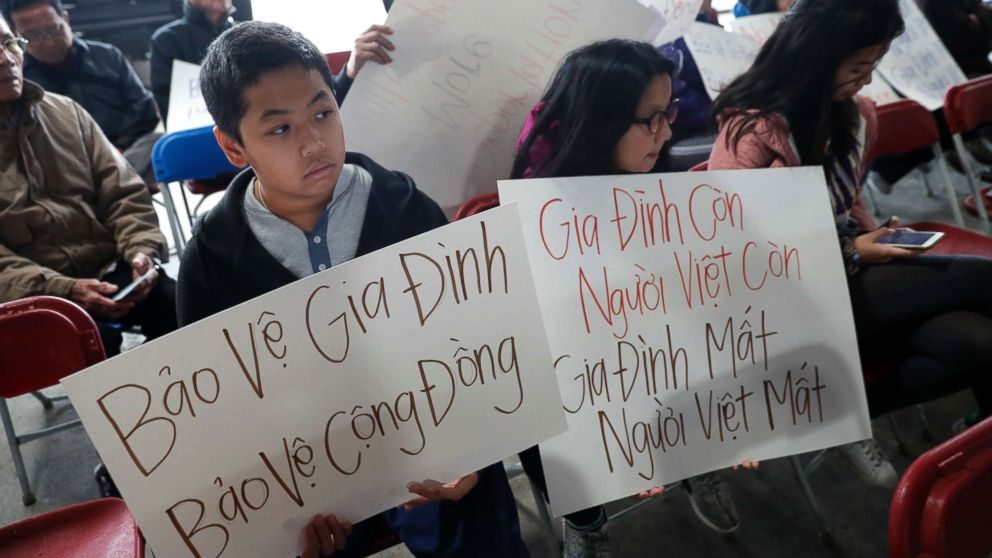A rally protesting President Donald Trump’s deportation policy to deport Vietnamese refugees (Source: ABC News)
Anna Nguyen
Introduction
During his first few months in office, President Donald Trump committed to a political agenda that was as controversial as his presidential campaign. With immigration at the forefront of his priority list, Trump advocated for the end of processes like chain migration and the Visa Lottery while bolstering support for a border wall. Prior to their exit from the White House, members of the Trump administration made an additional effort to severely reduce refugee admissions for the 2021 fiscal year.[1] These policy goals antagonized refugees and other undocumented residents who had to face higher risks of deportation as a result. Trump’s view of refugees as unwanted burdens to the United States has, if anything, remained consistent over his tenure as president.
What has riled many in the Vietnamese American community the most was the Trump administration’s dogged effort to deport former Vietnamese refugees without citizenship status who were convicted of crimes. Under George W. Bush’s presidency in 2008, the United States and Vietnam had signed a memorandum of understanding (MOU) on the repatriation of Vietnamese people who lived in the America but had violated US law. This 2008 MOU specifically excluded Vietnamese refugees who had arrived on American soil before July 12, 1995, the date when the two countries normalized relations.[2] In early 2017, however, the Trump administration sought to reinterpret the agreement to include Vietnamese American noncitizens who had been granted asylum before the above 1995 date, setting in motion a contentious process.[3]
Although this policy initiative seemed to be a natural extension of Trump’s general xenophobia and anti-immigrant attitude, it actually mirrors the general trend of policies adopted by previous presidents and possibly foreshadows the actions of the current Biden administration. Through the case of Vietnamese refugee deportations, this three-part series will argue that despite the apparent inconsistences, immigration policy in the United States in the twenty-first century is remarkably consistent and reflects a long-term trend since 2001.[4] These standards were sparked by George W. Bush, continued under Barack Obama, inflamed by Donald Trump, and exist today as durable political norms inherited by Joseph Biden and his administration.
Deportation Policy from Bush to Obama
The twenty-first century was barely in its second year when tragedy struck America with the coordinated attacks by Islamist terrorists on September 11, 2001. These historic events came to shape the George W. Bush administration: as the US chased its enemies abroad from the Afghan hills to the Tigre River to the West Saharan desert, efforts were made at home to strengthen the border and domestic surveillance through such laws as the Patriot Act and the Enhanced Border Security and Visa Entry Reform Act. A new Department of Homeland Security was created following the Homeland Security Act of 2002, bringing together dozens of federal agencies and hundreds of thousands of employees.
In such a political landscape, President Bush left a legacy full of contradictions. On the one hand, he supported the Deferred Action for Childhood Arrivals (DACA) and championed a comprehensive immigration reform that opened a pathway to illegal immigrants for citizenship. The Bush administration also accepted a larger number of refugees and asylum-seekers than his predecessor. On the other hand, Bush stepped up the deportations of illegal immigrants through an informal process called “returns” by which immigrants were rounded up and sent off across the border by bus without any record. According to a New Republic article, more than 8 million immigrants were deported as “returnees” during 2001-2008, four times more than those who underwent a formal process of “removal” that consisted of appearing before an official or a judge prior to deportation.[5]
President Barack Obama assumed office in a different political context, but his legacy on immigration is similarly mixed. Although his executive actions on the DACA shielded about 750,000 young unauthorized immigrants who were brought over to the United States as children, his staunch enforcement of immigration laws led to his designation as the “deporter-in-chief” by the National Council of La Raza.”[6] Obama’s immigration agenda continued the Bush era’s focus on removing undocumented immigrants with criminal convictions, and his administration prioritized the formal deportation of more illegal immigrants than any previous administration in American history.[7] However, if one counts the number of deportees who went through the formal process in addition to those identified as returnees, Bush came out the winner.
The Deportation Pipeline and Young Vietnamese Refugees
By the time President Trump came into office in 2016, thousands of former Vietnamese refugees with criminal records were living in a legal limbo that can be likened to a pipeline for deportation. Many refugees immigrated to America as young adults and committed offenses that led to incarceration at the end of the twentieth century. Most were released after completing their sentences, but those without citizenship were almost immediately transferred from prison to detention centers run by Immigration and Customs Enforcement (ICE). But because the Vietnamese government had refused to accept deportees from the US before the 2008 MOU, the detainees were usually released after six months. These individuals were able to reunite with their families but faced a future of fear and uncertainty since they could be summoned, detained, and deported at any time when the Vietnamese government changed its mind. While there is no study of who these Vietnamese Americans are, most of them likely belong to a category of refugees known as the “1.5 generation” since they arrived in the United States as children or young adults. While eligible for citizenship, a large number of them never applied for it perhaps due to deficiency in the English language and lack of understanding of the legal process.
Because members of the 1.5 generation grew up in the United States and were socialized into American culture, they have little connection to their homeland. Many in this group had parents who fought against the communists for the Republic of Vietnam. A significant number of those 1.5 generation refugees were Vietnamese Amerasians, born from Vietnamese women and American servicemen in South Vietnam before coming to the US under the Amerasian Homecoming Act in 1987.[8] These children were perceived as unwanted consequences of war and were horrifically treated as such in postwar Vietnam. Youths with lighter complexions or other distinct physical features distinguished themselves as mixed-race and experienced harassment from their peers. Many children were abandoned by their parents or were in this situation because their caregivers were unable to adequately provide for them.
Even though they were allowed to resettle in the United States, Vietnamese Amerasians were still marked with a similar magnitude of displacement and loss.[9] For children, the losses of cultural and social capital hindered their acclimation efforts. With few exceptions, situations of severe family and financial instability led many refugee children to drop out of school and turn to the streets for other avenues of economic and social stability. Gangs came to replace families and led many to prison.[10] The Asian American prisoner population increased by 250 percent during the last two decades of the twentieth century as a result of draconian sentencing laws in response to the rise of organized urban crime.[11] For those Vietnamese gang members who were not citizens, the prison led directly into the deportation pipeline.
Data collected by Syracuse University researchers from 1998 to 2020 shows that the number of Vietnamese nationals who underwent deportation proceedings were highest during 1998-2004 with about 600 cases per year. This number declined to about 450 per year during 2005-2012, and further decreased to 200 per year after 2012.[12] The downward trend is encouraging and indicates an increasingly smaller stream feeding into the pipeline over time. Nevertheless, this decades-old pipeline today contains thousands of deportable Vietnamese Americans and will certainly suck in more of them. When Donald Trump came into office in January 2017, he inherited the pipeline and was determined to find an exit for it. The next section in this series will examine Trump’s ruthless effort to deport Vietnamese refugees despite strong criticisms and opposition to that policy.
References
Caplan-Bricker, Nora. “Who’s the Real Deporter-In-Chief: Bush or Obama?” New Republic. April 17, 2014. https://newrepublic.com/article/117412/deportations-under-obama-vs-bush-who-deported-more-immigrants.
Congress.gov. “H.R.3171 – 100th Congress (1987-1988): Amerasian Homecoming Act.” August 19, 1987. https://www.congress.gov/bill/100th-congress/house-bill/3171.
Dunst, Charles and Krishnadev Calamur. “Trump Moves to Deport Vietnam War Refugees.” The Atlantic. December 12, 2018. https://www.theatlantic.com/international/archive/2018/12/donald-trump-deport-vietnam-war-refugees/577993/.
Department of Homeland Security. “Aliens Removed Or Returned: Fiscal Years 1892 To 2015.” 2015 Yearbook of Immigration Statistics. https://www.dhs.gov/immigration-statistics/yearbook/2015/table39.
Epstein, Reid J. “NCLR head: Obama ‘deporter-in-chief’.” Politico. March 4, 2014. https://www.politico.com/story/2014/03/national-council-of-la-raza-janet-murguia-barack-obama-deporter-in-chief-immigration-104217.
Mortland, Carol A. and Judy Ledgerwood. “Secondary Migration Among Southeast Asian Refugees In The United States.” Urban Anthropology and Studies of Cultural Systems and World Economic Development 16, no. 3 (1987): 291-326. http://www.jstor.org/stable/40553109.
Oh, A. and Umemoto, K. “AAPIs: From incarceration to re-entry.” Amerasian Journal 31, no. 3 (2005): 43-59.
Phan, Shandon. “Vietnamese Amerasians in America.” Asian-Nation: The Landscape of Asian America. 2003. http://www.asian-nation.org/amerasians.shtml#sthash.fxGkCICk.KXpHq8Ja.dpbs.
“Vietnam (08-322) – Agreement on the Acceptance of the Return of Vietnamese Citizens.” Office of Treaty Affairs, Department of State. March 22, 2008. https://www.state.gov/08-322.
Yam, Kimberly. “The Forgotten Asian Refugees Fed Into The U.S. Prison System.” HuffPost. January 29, 2018. https://www.huffpost.com/entry/southeast-asian-prison-deportation-pipeline_n_5a1dd48ee4b0569950233065.
Notes
[1]Julie Watson and Matthew Lee, “Trump plans to slash refugee admissions to US to record low,” Associated Press, September 30, 2020, https://apnews.com/article/virus-outbreak-donald-trump-politics-united-states-immigration-f76797b97e8a0b66150d0269fe4f432b.
[2] “Vietnam (08-322) – Agreement on the Acceptance of the Return of Vietnamese Citizens,” Office of Treaty Affairs, Department of State, March 22, 2008, https://www.state.gov/08-322
[3] Charles Dunst and Krishnadev Calamur, “Trump Moves to Deport Vietnam War Refugees,” The Atlantic, December 12, 2018, https://www.theatlantic.com/international/archive/2018/12/donald-trump-deport-vietnam-war-refugees/577993/.
[4] Although we focus only on Vietnamese Americans, a larger number of Cambodian and Laotian Americans have been deported. While Cambodia and Vietnam have a repatriation treaty with the US, Laos does not. Cambodia’s repatriation agreement with the US was signed in 2002 under President Bush. See http://searaids.org/cambodia/ and http://searaids.org/laos/. What the Trump administration did to force the Laotian government to accept deported Laotian Americans was to deny or delay entry visas for Laotians, including government officials, to enter the US. https://www.searac.org/immigration/searac-condemns-trump-administrations-expanded-visa-sanctions-on-laos/
[5] Nora Caplan-Bricker, “Who’s the Real Deporter-In-Chief: Bush or Obama?” New Republic, April 17, 2014, https://newrepublic.com/article/117412/deportations-under-obama-vs-bush-who-deported-more-immigrants.
[6] Reid J. Epstein, “NCLR head: Obama ‘deporter-in-chief’,” Politico, March 4, 2014, https://www.politico.com/story/2014/03/national-council-of-la-raza-janet-murguia-barack-obama-deporter-in-chief-immigration-104217.
[7] Department of Homeland Security, “Aliens Removed or Returned: Fiscal Years 1892 To 2015,” 2015 Yearbook of Immigration Statistics, https://www.dhs.gov/immigration-statistics/yearbook/2015/table39.
[8] Congress.gov, “H.R.3171 – 100th Congress (1987-1988): Amerasian Homecoming Act,” August 19, 1987, https://www.congress.gov/bill/100th-congress/house-bill/3171.
[9] Shandon Phan, “Vietnamese Amerasians in America,” Asian-Nation: The Landscape of Asian America, 2003, http://www.asian-nation.org/amerasians.shtml#sthash.fxGkCICk.KXpHq8Ja.dpbs.
[10] Kimberly Yam, “The Forgotten Asian Refugees Fed into the U.S. Prison System,” HuffPost, January 29, 2018, https://www.huffpost.com/entry/southeast-asian-prison-deportation-pipeline_n_5a1dd48ee4b0569950233065.
[11] A. Oh and K. Umemoto, “AAPIs: From incarceration to re-entry,” Amerasian Journal 31, no. 3 (2005): 43-59.
[12] The trend for Laotian nationals is similar to that for Vietnamese while the trend for Cambodians saw the number rising to its peaks in the second Bush term and first Obama term, and declined thereafter. See https://trac.syr.edu/phptools/immigration/court_backlog/deport_outcome_charge.php

 Politics & Economy4 years ago
Politics & Economy4 years ago
 Politics & Economy2 years ago
Politics & Economy2 years ago
 After 19751 year ago
After 19751 year ago
 ARCHIVES5 years ago
ARCHIVES5 years ago
 Society & Culture5 years ago
Society & Culture5 years ago
 Politics & Economy4 years ago
Politics & Economy4 years ago
 Politics & Economy5 years ago
Politics & Economy5 years ago
 Politics & Economy4 years ago
Politics & Economy4 years ago







